Swing Your Partner!
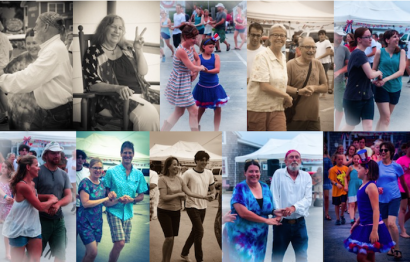
Your next opportunity learn the Ocracoke Square Dance is at the Fig Festival on August 12th. Philip Howard will be caller, leading the dance to music provided by local band Molasses Creek. The Square Dance is scheduled for 6-8pm, and is free and fun for all ages!
Traditional Square Dance of Ocracoke Island, North Carolina
By Philip Howard, Copyright 2011
The Ocracoke Island square dance is actually a big circle dance, much like big circle dances performed in the Appalachian Mountains of the eastern United States. However, islanders traditionally referred to their dance as a square dance (to distinguish it from a “round" or ballroom dance).
Almost all of the island’s original European settlers (like the early settlers of the Appalachians) hailed from the British Isles, and they brought their dance traditions with them. The Ocracoke square dance incorporates many features of English country dances, the most popular dance performed during the American colonial period.
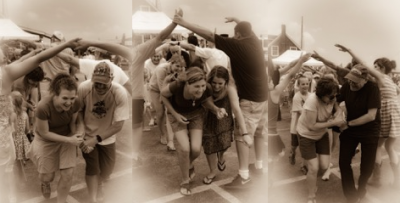
From the mid 1700s until the early 1960s the Ocracoke square dance was held regularly on this small, isolated island twenty miles off the coast of North Carolina. In the eighteenth and nineteenth centuries the dances were often held in private homes. Later they were held in public spaces including the lodge of the old Doxsee Clam Factory, on the dock at Captain Bill Gaskill’s Pamlico Inn, at Stanley Wahab’s Silver Lake Inn (now the Island Inn), and in the building that now houses the Ocracoke Variety Store.
By the middle of the twentieth century several factors combined to nearly extinguish the dance. The establishment of a WWII naval base on the island, and subsequent improvements in transportation and communication (paved roads, ferry service, telephones, radios and television), led to a dramatic increase in connections to the outside world and to tourism.
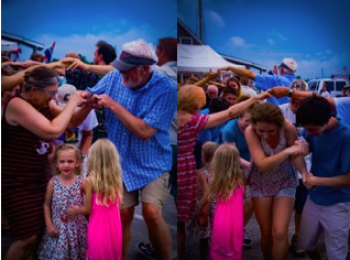
During the latter half of the 1950s and the early 1960s square dances were held in the Ocracoke School Recreation Hall, an abandoned WWII building that had been moved to school property. With the steady increase in tourism an ever larger number of attendees were unfamiliar with the dance. There was no precedent for teaching the dance to newcomers, and islanders soon became frustrated with the confusion and disorder that resulted. Rock & roll and the jitterbug, the popular music and dance of the 1950s, soon displaced the traditional island square dance.
Although there were occasional attempts to revive the dance in the 1970s these endeavors were thwarted by the steady decrease in the number of islanders who were familiar with the dance, and by the lack of a qualified teacher.
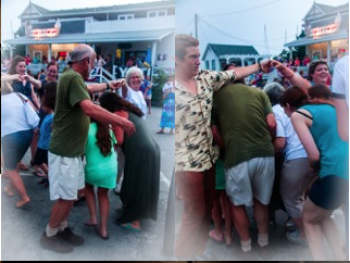
In 1992 Bob Dalsemer, president of the Country Dance and Song Society, came to the island to share his enthusiasm for traditional dance with island school children. While on the island he learned of Ocracoke’s dance and conducted several interviews. His article, “Old Time Square Dancing on Ocracoke Island, North Carolina: Notes from Interviews with Ocracoke Island Dancers, September 13-15, 1992” was published in Country Dance and Song Magazine, #26.
It had been thirty to sixty years since Dalsemer’s interviewees had actually performed the dance, and, sadly, no one alive was able to reconstruct it faithfully.
However, in 1996 a small group of islanders gathered in the Ocracoke School gymnasium, along with several musicians, to attempt to recreate the Ocracoke Island square dance. It soon became apparent that our bodies remembered what our minds had forgotten. In the course of one evening the essential elements of the dance were recaptured.
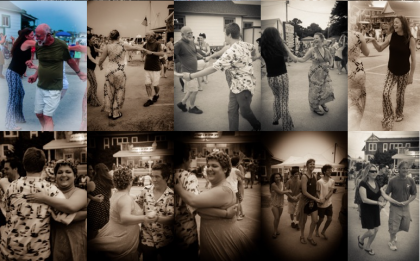
In subsequent years the Ocracoke square dance has been performed periodically at community events, including Independence Day celebrations, and the annual Ocrafolk Festival, and the upcoming Fig Festival.
Because nearly everyone in Ocracoke village knew the dance well, and because it originated before electronic amplification, there was a minimum of calling, and the caller always joined in the dance. There was no rhyming patter as in western square dances. Generally the dancers just watched and followed the caller.
There were times when the Ocracoke Island square dance was only loosely synchronized with the beat of the music. “This is typical of the big circle dance where the figures are not bound to the structure of the music" but "can be danced with more or fewer steps according to the whim of the dance leader." (Source: History of Square Dance) Although the dance naturally followed the rhythm of the music it often happened that couples would so enjoy swinging that they would continue beyond the customary number of beats. I liken the traditional Ocracoke dance to the fluid flight pattern of cormorants, while other dances, with their more precise structures, are more like the tight “V” pattern of Canada geese.

The main feature of the dance is a series of figures, rather than steps, because dancers form patterns with their partners and other couples as the dance progresses. The basic dance step is a simple walk, a subtle flat-footed two-step, or a shuffle, never a bounce or a skip, although fancier clogging may be added at appropriate times. Dance steps should never interfere with the figures.
Though less rigid than some dances, the dance flowed smoothly from one figure to the next, providing a sense of continuity, form and grace. Because this is a circle dance any number of couples could join. It was only limited by the size of the dance floor.
The dance is organized around three main sections characterized in turn by a beginning large circle; a repeated 2-couple figure (the “square,” which could be one of several different figures, including “Birdie in the Cage” and “Dive for the Oyster, Dig for the Clam”), and an ending large circle. The dance always ends with “Swing your partner... and thank your partner.”

The Ocracoke square dance, like the Appalachian big circle dances and other folk dances, is part of a dynamic process that evolves and changes over time and in each place. Almost certainly, some of the elements of the Ocracoke square dance have been lost to time.
The Ocracoke dance is very forgiving. Have fun, and don’t worry if you get confused. The Ocracoke square dance has always been an opportunity to relax, enjoy life, and be happy.
A longer and more detailed version of this article originally appeared on the Square Dance History Project website. Used by author's permission.







